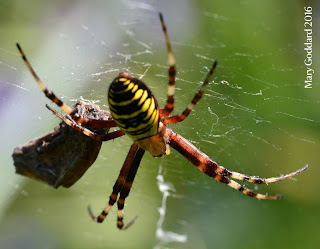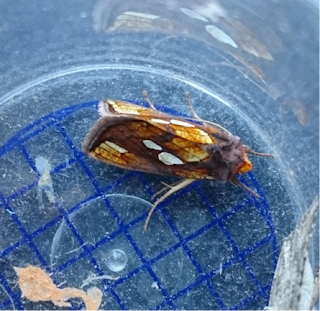We were blessed with
good weather this week, perfect for a morning wetland bird survey count on the
5th. The highlight was a lovely group of five Pintails feeding on the
edges of the flooded marsh. It’s “bottoms up” for the Pintail as they feed by
‘up-ending’, with only their rumps and frantic webbed feet visible above water
as they search with their bills for the seeds and roots of aquatic plants.
Large flocks of Ringed Plover and Dunlin have been scattering the shingle beach
each morning with the tides. Most are juveniles which are distinguishable by
the faded mask and bib and yellower leg colour.
The male Black Redstart is still
enjoying the Point and has graced us with some fine views all week. Other
sightings have included Pied and Spotted Flycatchers, Common and Lesser Whitethroat, Willow Warblers, Chiffchaff, Sedge Warbler, Blackcap, Yellow
Wagtail and plenty of Wheatears and Whinchats.
Sedge Warbler in the Garden (D. Wynn)
With the winds picking up and
sightings of shearwater moving along the coasts, the rangers have had some
opportunities to put scope to sea and spend some time looking for these passage
seabirds. We got a bit of a surprise when we were visited by this adult winter Guillemot who came incredibly close to the shore to feed. The Grey Seals found
it fascinating too and at one point the Guillemot appeared to be accompanied by
a five- strong grey seal entourage!
With the help of the tractor, the
mobile hide has now been moved up the ridge and placed in the dunes. The
hide is open and offers some shelter if you find yourself caught in the rain after
a walk up the ridge.
Join us for a beach clean and
help clean up our coastline!
Remember that on Saturday 17th
September from 10am until 1pm we will be holding our end of season beach clean as
part of Marine Conservation Society's Big British Beach Clean. If you have some
time to spare and you would like to help, please join us for as little or as
long as you would like, don your gloves and pickers and help make Blakeney’s
coastline litter free for people and for our important wildlife. On our last
beach clean, with the help of kind folk like you, we amassed an impressive pile,
so thank you for your continued support. For more details about the event,
please ring the Norfolk Coast National Trust office on 01263 741694.
A message from Belgium!
This message in a bottle was
found on the beach by the rangers during the wetland bird survey this week and
appears to have come all the way from a beach in Belgium! The message written in
French by a Belgian family is dated the 31st July 2016 and was found
here at Blakeney on the 5th September 2016 having taken 37 days to
travel across the North sea from the Belgian coastal town of Blakenberge to the
tideline of Blakeney Point!
A quote in the message reads “if
you reach for the moon you'll land among the stars”.
Us rangers don’t usually condone
littering but we must admit, we thought this was a pretty exciting discovery!














































